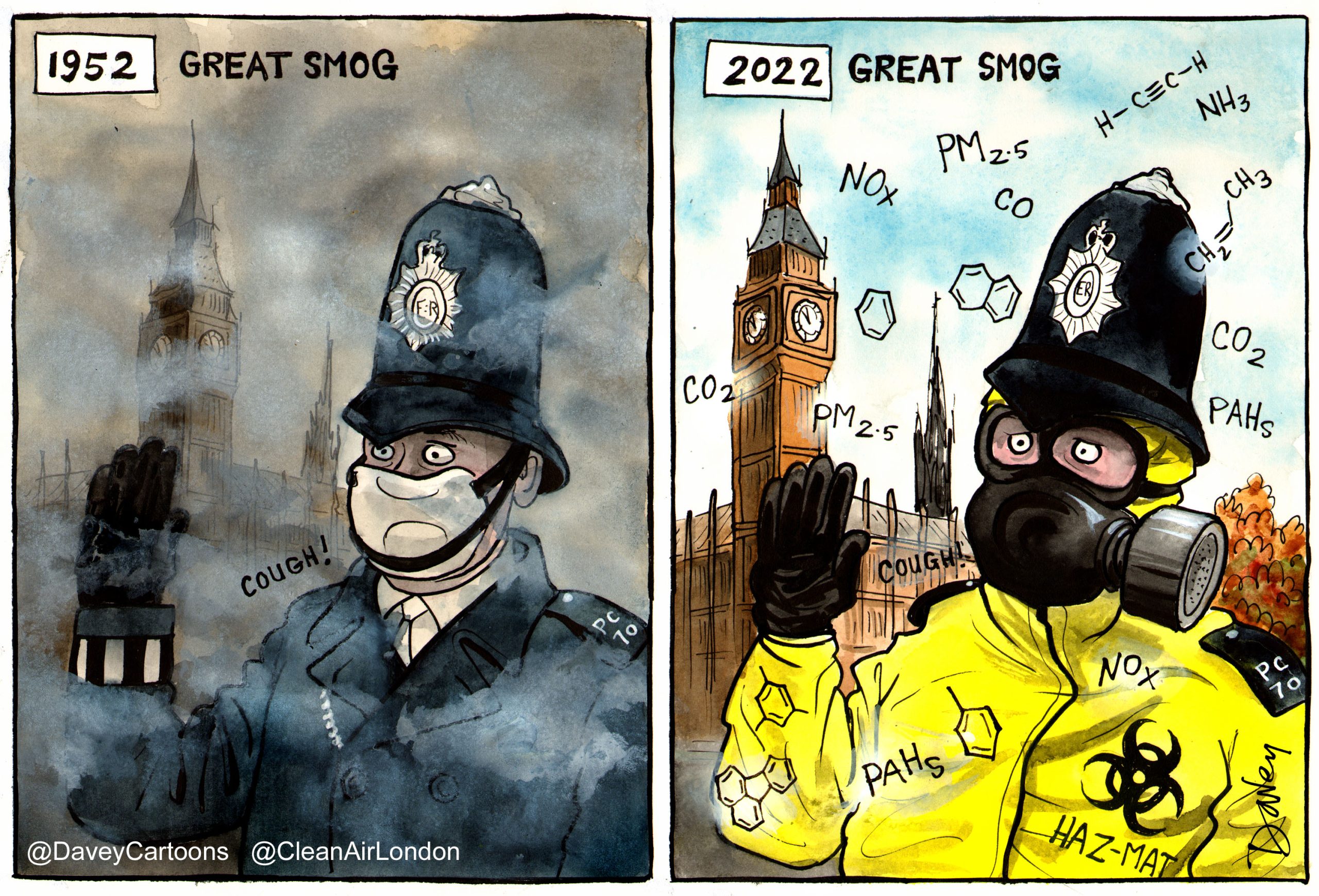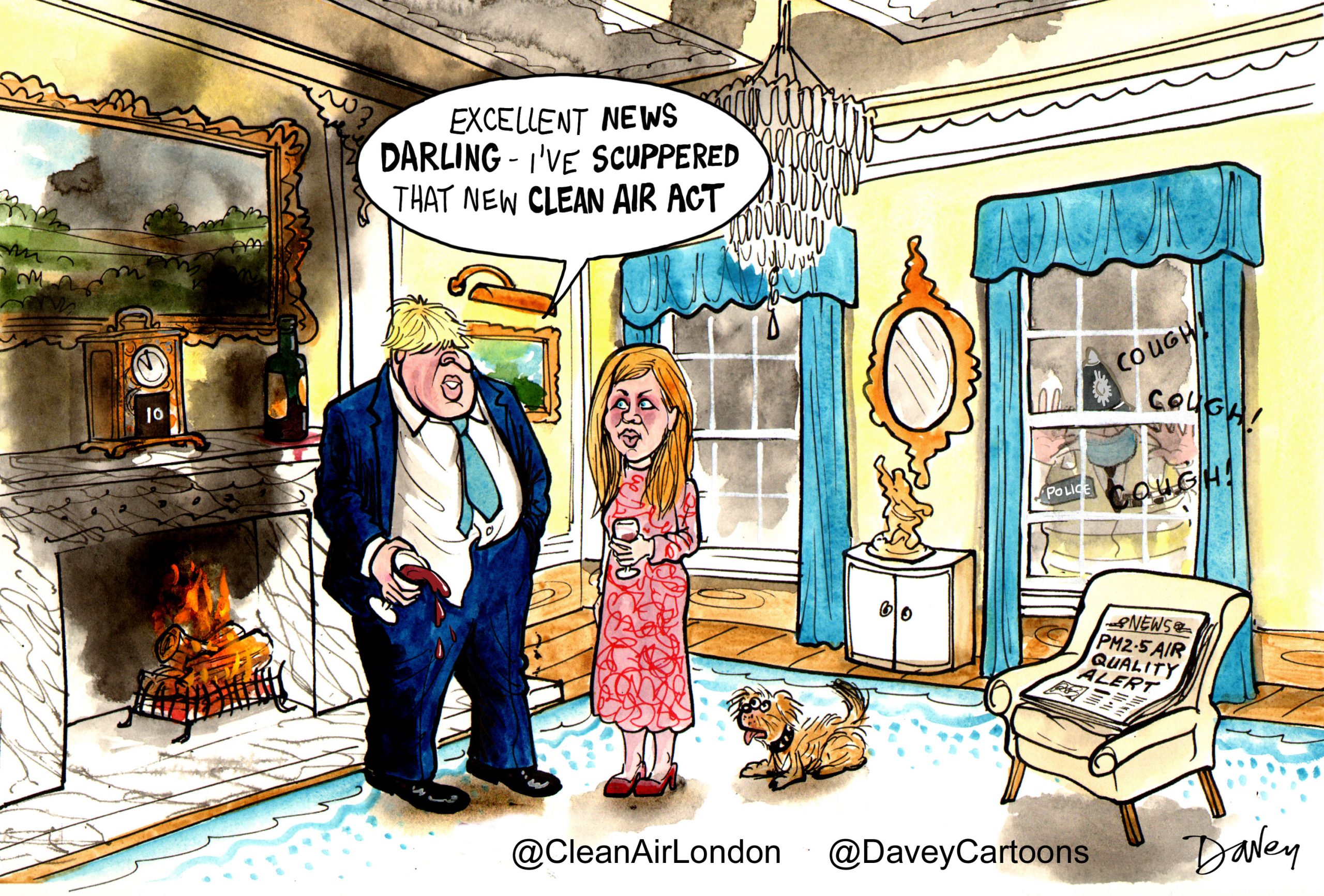Environmental information request shows Mayor Johnson is failing to warn Londoners and may be actively seeking to mislead us about the biggest public health crisis since the Great Smog of 1952. 4,000 early deaths in 1952 changed the world but 4,000 in the Olympic year are considered ‘room for improvement’
Mayor Johnson’s response to this invisible crisis has been a succession of backward steps on air quality including the 15 month postponement of Phase 3 of Mayor Livingstone’s planned low emission zone. Phase 3 was designed to protect over 15% of those most exposed to air pollution
London, as the Olympic City, should be leading the world. Instead its low emission zone is still two steps and two years behind the ‘quick and inexpensive to implement’ Berlin equivalent
Mayor Johnson is implementing Phases 3 and 4 of the London low emission zone (LEZ) on 3 January 2012 to ban more of the most polluting diesel vehicles from Greater London. Further details can be seen on Transport for London’s (TfL’s) website:
http://www.tfl.gov.uk/roadusers/lez/default.aspx
Quotes
Simon Birkett, Founder and Director of Clean Air in London, said:
“You wouldn’t know it if you listen to Mayor Johnson or the Government, but London – the Olympic City – is in the midst of the biggest public health crisis since the Great Smog of 1952. Only smoking is likely to cause more early deaths than air pollution in London.
“There were as many early deaths attributable to long-term exposure to air pollution in London in 2008 (i.e. 4,267) as we thought occurred during the Great Smog due to short-term exposure (4,075) when we knew nothing about the health impact of long-term exposure. Scientists have only known about the impacts of long-term exposure for about 10 years. Some estimates suggest one in three Londoners dying every year are losing on average an additional three years of life due to air pollution.
“Mayor Johnson’s response to this invisible crisis has been a succession of backward steps on air quality measures including the 15 month postponement of Phase 3 of the low emission zone (LEZ). Phase 3 alone, developed with the rest of the LEZ by Mayor Livingstone in 2006 and 2007, was designed to protect over 15% of the Londoners most exposed to air pollution. Its launch today with Phase 4 is a long overdue step to improve public health in London and reduce social and economic inequalities from traffic-related air pollution.
“To cap it all, an Environmental Information Request by ‘Clean Air in London’ has found Mayor Johnson judges air pollution by what he can see rather than what we know it is doing to Londoners’ health. Very oddly, the Mayor’s officials have been seeking a ‘commitment’ from potential partners to ‘push’ similar themes and provide ‘evidence to demonstrate activity’. Why is it that 4,000 early deaths in 1952 changed the world but 4,000 in the Olympic year – at an average statistical loss of life of 11.5 years – are considered ‘room for improvement’? Is it simply the difference between short-term exposure to visible air pollution then and long-term exposure to invisible air pollution now? What about the discovery by leading scientists in 2010 that traffic-related air pollution may be causing 15-30% of all new cases in asthma in children?
“Even after the latest changes, London’s LEZ is still two steps and two years behind the Berlin low emission zone that has banned pre-Euro 4 diesel vehicles of all sorts from the most polluted parts of the city. The Germans say it has been ‘the most effective single measure in Berlin’ to improve air quality. Mayoral candidates should commit to introduce quickly a Berlin-type low emission zone in central and inner London and tighten further the existing (outer) low emission zone. A tighter inner low emission zone, long championed by Darren Johnson AM (Green) and Mike Tuffrey AM (Liberal Democrat), would be ‘quick and inexpensive to implement’ according to Transport for London and would avoid the need to: introduce the tightest standards throughout London; and/or affect all vehicles.
“London should be leading the world in tackling air pollution as it did after the Great Smog of 1952 not failing to warn or misleading Londoners about this invisible public health crisis.”
Low emission zone
Air pollution in London is much worse than most of us have realised.
According to the Mayor’s Air Quality Strategy 2010, road transport contributed around 80% of emissions of the most dangerous airborne particles (PM2.5) in Greater London in 2008 (page 41). According to the Department for Transport, diesel transit size vans produce 24.4 times the PM10 emissions and 20% more oxides of nitrogen than their petrol equivalent (in grams/mile). Most, larger vehicles, and around 50% of new passenger vehicles, use diesel engines.
There are two main approaches to tackling traffic related air pollution: emission measures and congestion measures. A low emission zone (LEZ) targets harmful vehicle emissions at their source and may have a secondary benefit of reducing congestion. It contrasts with: congestion measures, which require road users to pay a daily charge and may have a secondary benefit of reducing harmful emissions; and ‘dust suppressants’ or ‘green walls’ that seek to remove emissions from the air. Unlike congestion charging, there is no daily charge once a vehicle complies with an LEZ standard.
The London LEZ requires certain vehicles to meet a minimum theoretical standard equivalent to the Euro 3 or Euro 4 engine emission standard for particulate matter i.e. a vehicle does not need to have a Euro 3 or Euro 4 engine per se. In practice, because of the vehicle size thresholds, only diesel vehicles are affected. For the largest vehicles these standards are called Euro III and Euro IV.
Phases 1 and 2 of the London LEZ entered into force on 4 February and 7 July 2008 respectively. Phase 3 of the LEZ includes for the first time larger vans, and minibuses registered as new before 1 January 2002. Phase 4 tightens existing standards for lorries, buses and coaches registered as new before 1 October 2006.
Phase 3, which was designed by Mayor Livingstone in 2006 and 2007 to protect over 15% of those most exposed to air pollution, was postponed by Mayor Johnson from 4 October 2010. Mayor Johnson expected the postponement of Phase 3 of the LEZ to result in exhaust emissions of dangerous airborne particles (PM10) and oxides of nitrogen (NOx) being higher by 10 tonnes and 340 tonnes respectively mainly in 2010.
Vehicle operators have several options including: purchasing a new or second-hand vehicle; fitting a diesel particulate filter approved by TfL; paying a daily fine; hiring a vehicle; or not driving in the zone.
Environmental Information Request
A response to an Environmental Information Request dated 15 December 2011 shows TfL seeking partners ‘to deliver Cleaner Air for London’. The opening paragraph of the proposal says:
“The Mayor wants London to be one of the cleanest, greenest cities in the world to ensure that people living here enjoy a great quality of life. The Mayor recognises that poor air quality has an adverse effect on people’s health and wellbeing. London’s air quality is hugely better than it was 50 years ago but there’s still room for improvement”.
Later it says:
Key messages
- London’s air quality is hugely better than it was 50 years ago but there is still room for improvement
- Together we can help London breathe better – turn off your engine when parked or when picking up and dropping off people or goods
What we can offer you
We are still exploring options for marketing and awareness raising, however some of the exposure opportunities we can offer include:
- Possible logo/branding opportunities on our marketing collateral (e.g. posters across Greater London)
- Media launch with the Mayor (or Mayoral representative)
- Regular media and social media activity across the period of the campaign
- Potential for web links/inclusion of organisation and key messages in web copy
- Possible use of campaign logo/brand
- Possible access to celebrity campaign advocates
What we seek in return
- Access to spokespeople, advocates and supportive quotes for media use
- Commitment to push campaign messages to own audiences, and evidence to demonstrate activity
- Supportive parallel communications activity
- Case studies
CAL emphasis.
Notes
1. CAL response to TfL consultation on the postponement of Phase 3 of the low emission zone
https://cleanair.london/legal/mayors-consultation-on-the-removal-of-the-wez/
2. CAL response to Environmental Audit Committee on health impacts of air pollution
https://cleanair.london/solutions/the-worst-public-health-crisis-since-the-great-smog-of-1952/
3. Diesel is worse than petrol for PM and NOx
http://www.publications.parliament.uk/pa/cm201011/cmhansrd/cm111003/text/111003w0001.ht m#1110033001281
Link no longer available
3. Euro engine emission standards
http://www.dieselnet.com/standards/eu/hd.php#stds
4. TfL website: Low emission zone
http://www.tfl.gov.uk/roadusers/lez/default.aspx
5. TfL’s Integrated Impact Assessment (pages 30 and 31)
http://www.tfl.gov.uk/assets/downloads/roadusers/lez/LEZ/LEZ-VO-Impact-Assessment-May-2010.pdf
6. Proposed London Low Emission Zone. See Annex A on page 45 (November 2007)
7. When planned in 2006 and 2007, Phase 3 was intended to reduce the number of people in London exposed to the highest levels of nitrogen dioxide (NO2), a toxic gas, and dangerous airborne particles (PM10) by 16% to 18%.
http://www.tfl.gov.uk/assets/downloads/roadusers/lez/supplementary-info.pdf
8. Environmental Appraisal of the Proposed London Low Emission Zone (November 2006)
http://www.tfl.gov.uk/assets/downloads/roadusers/lez/LEZ/environmental-impact-assessment.pdf
9. Mayor’s Air Quality Strategy 2010
http://www.london.gov.uk/publication/mayors-air-quality-strategy
10. MQT answers
London’s Taxi Fleet Emissions (Caroline Pidgeon AM on 2 February 2010)
The Mayor told Caroline Pidgeon on 2 February 2010 that if all current taxis were to meet the Euro 4 emission standard for PM and NOx there would be an approximate annual saving of around 20 tonnes on PM10 and 250 tonnes of NOx compared to the current taxi fleet.
http://mqt.london.gov.uk/mqt/public/question.do?id=29778
11. PM10 from London’s taxis and private hire vehicles (Murad Qureshi AM on 9 November 2011)
The Mayor told Murad Qureshi on 9 November 2011 that 23,344 licenced taxis and 54,252 licenced private hire vehicles generate a total of 72 tonnes and 44 tonnes of PM10 and 697 and 677 tonnes of NOx respectively.
http://mqt.london.gov.uk/mqt/public/question.do?id=38220
12. CO2 and NOx from London’s taxis and private hire vehicles (Murad Qureshi AM on 9 November 2011)
http://mqt.london.gov.uk/mqt/public/question.do?id=38205
13. Low emission zones in Europe
http://www.lowemissionzones.eu/
14. Berlin low emission zone
Details
15. Impact analysis
http://www.citeair.eu/fileadmin/Events/June_2009_events_in_Paris/Conference_Presentations/2_ Lutz-LEZ-Jun09-EN-fin Compatibility_Mode_.pdf
16. Benefit to cost ratio of 2.3 to 17.2 times
http://www.theyworkforyou.com/wrans/?id=2011-11-21b.80294.h#g80294.r0
17. NOx transect (North-South) across London









